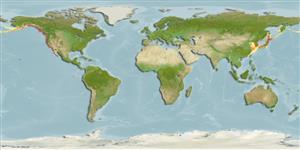Elasmobranchii (tubarões e raias) (sharks and rays) >
Squaliformes (Sleeper and dogfish sharks) >
Squalidae (Dogfish sharks)
Etymology: Squalus: Genus name from Latin 'squalus' meaning shark (Ref. 6885, 27436); suckleyi: Named for George Suckley who collected the specimens used by Charles Girard in his original description..
More on author: Girard.
Issue
Squalus suckleyi (Girard, 1855) has been resurected by Ebert et al. (2010: Ref. 85328) in the North Pacific where it replaces Squalus acanthias Linnaeus, 1758.
Environment: milieu / climate zone / depth range / distribution range
Ecologia
marinhas; estuarina bentopelágico; intervalo de profundidade 15 - 1244 m (Ref. 119696). Subtropical; 7°C - 15°C (Ref. 85328); 67°N - 29°N, 128°E - 115°W
North Pacific: Korea, Japan, northward to Russia (Kamchatka, Sea of Okhotsk and Sakhalin), the Bering Sea and the Aleutian Islands; eastwards in the Gulf of Alaska, British Columbia and Washington south to southern Baja California.
Length at first maturity / Tamanho / Peso / Idade
Maturity: Lm 94.4, range 79 - 110 cm
Max length : 140 cm TL macho/indeterminado; (Ref. 119696)
Descrição breve
Morfologia | Morfometria
Vértebras: 97 - 106. This large-sized, slender bodied species is distinguished by the following set of characters: body slender, trunk height 10.8 (8.3-12.0)% TL; snout rounded, somewhat blunted at apex, it is relatively short, with prenarial length 1.4 (1.3-1.5) times mouth width, preoral length 2.0 (2.1) times prenarial length, 9.1 (8.6-9.5)% TL; eye moderate-sized, its length 3.8 (3.2-3.9)% TL; anterior nasal flap simple, no secondary lobe; dorsal fins small, raked; first dorsal originates just posterior to free-rear tip of pectoral fin, the first dorsal-fin spine moderate, relatively narrow-based; pectoral fin lobe-like, not or weakly falcate; flank denticles broadly unicuspidate to weakly tricuspidate (Ref. 85328).
A demersal species found in coastal and oceanic waters; mainly epibenthopelagic which may be solitary or in groups (Ref.. 119696). It appears to prefer water temperatures between 7 and 15°C, and often makes longitudinal and depth migrations to follow this temperature preference (Ref. 48844). Reported taken at water temperatures of 0-12.7°C, with maximum catches at over 8° C. Juveniles are reported pelagic within the upper 25 m, settling to the bottom with maturity, mostly at 50-200 meters. Opportunistic feeders, with no specific targeted prey, but fishes are the main prey of larger individuals; also consumes squids, octopi, medusae, ctenophores, crustaceans (e.g., shrimps, euphausiids, and amphipods), and polychaetes (Ref. 119696). Edible but not appreciated. Its liver once served as a source of oil for mine lamps in the Nanaimo area (Ref. 6885). Due to the high mercury content in large individuals, it is recommended that only those less than 60 cm are eaten (Ref. 11007). Males mature at 70-80 cm TL (median age is 18.5 years) and females at 80-100 cm TL (median age 35.5 years) (Ref. 85328). In the high seas, this fish is taken as bycatch with salmon gillnet surveys from north of 40° to south of the Aleutian chain, over the Aleutian Basin and Bering Sea to about 60°N, along the chain and all across the Gulf of Alaska offshore; by bottom and pelagic trawls and gillnets northward from South Korea the Hawaiian Is., and southern California (Ref. 119696).
Distinct pairing with embrace (Ref. 205). Adult females undergo an extended resting period of 1 year or more between pregnancies (Ref. 91921).
Ebert, D.A., W.T. White, K.J. Goldman, L.J.V. Compagno, T.S. Daly-Engel and R.D. Ward, 2010. Resurrection and redescription of Squalus suckleyi (Girard, 1854) from the North Pacific, with comments on the Squalus acanthias subgroup (Squaliformes: Squalidae). Zootaxa 2612:22-40. (Ref. 85328)
Categoria na Lista Vermelha da IUCN (Ref. 130435)
Ameaça para o homem
Harmless
Utilização humana
Mais informação
ReferênciasAquaculturaPerfil para aquaculturaEstirpesGenéticaElectrophoresesHereditariedadeDoençasProcessamentoNutrientsMass conversion
ColaboradoresFotografiasStamps, Coins Misc.SonsCiguateraVelocidadeTipo de nataçãoÁrea branquialOutras referênciasCérebrosVisão
Ferramentas
Relatórios especiais
Descarregue XML
Fontes da internet
Estimates based on models
Preferred temperature (Ref.
123201): 5.1 - 17.3, mean 10.2 °C (based on 231 cells).
Phylogenetic diversity index (Ref.
82804): PD
50 = 0.5000 [Uniqueness, from 0.5 = low to 2.0 = high].
Bayesian length-weight: a=0.00933 (0.00346 - 0.02519), b=3.02 (2.79 - 3.25), in cm total length, based on LWR estimates for this (Sub)family-body shape (Ref.
93245).
Nível Trófico (Ref.
69278): 3.8 ±0.47 se; based on food items.
Resiliência (Ref.
120179): Muito baixo, tempo mínimo de duplicação da população maior que 14 anos (K=0.3-0.15; tm=14-36; Fec=6).
Fishing Vulnerability (Ref.
59153): Very high vulnerability (84 of 100).
